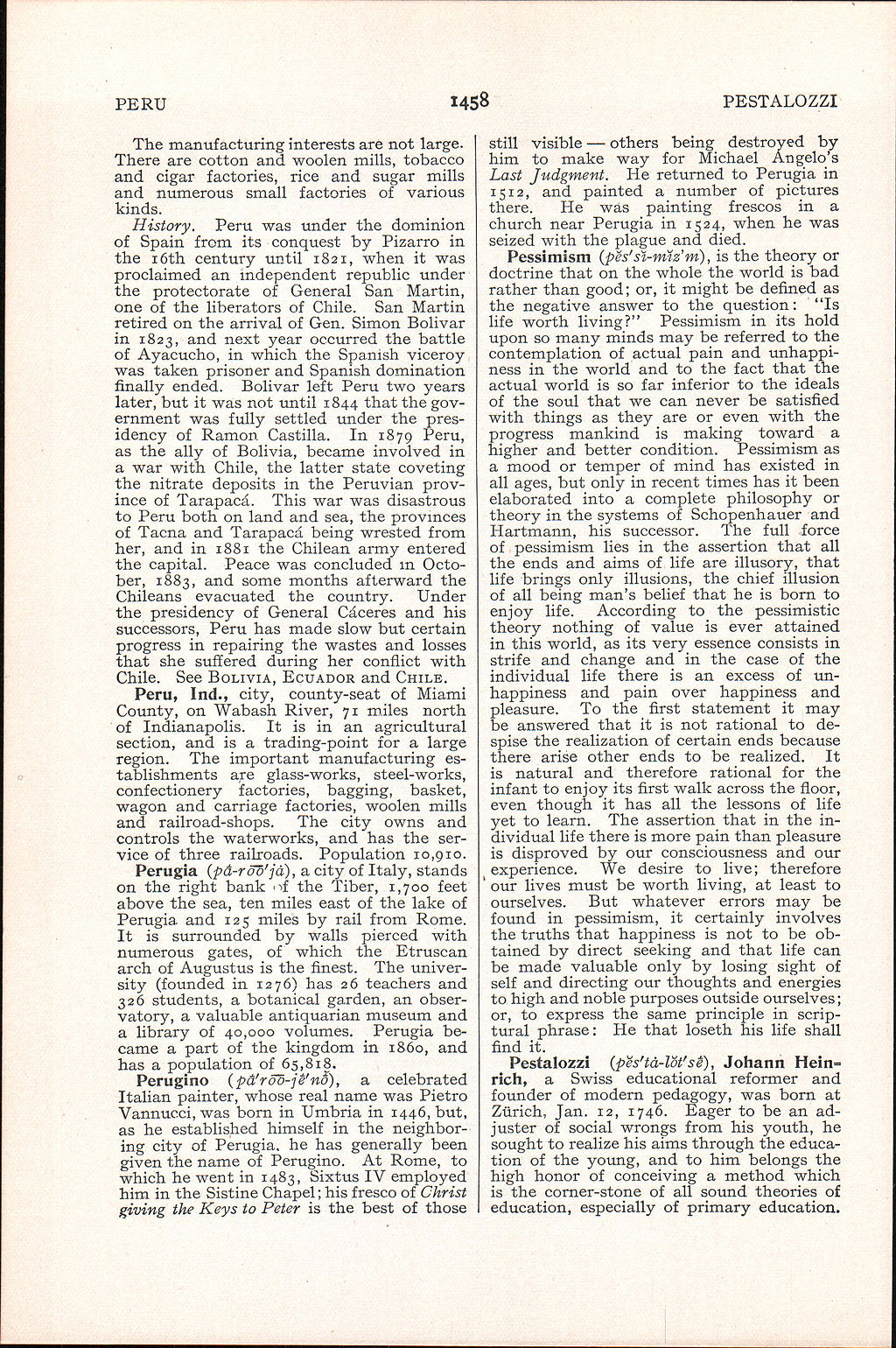PERU
1458
PESTALOZZI
The manufacturing interests are not large. There are cotton and woolen mills, tobacco and cigar factories, rice and sugar mills and numerous small factories of various kinds.
History. Peru was under the dominion of Spain from its conquest by Pizarro in the 16th century until 1821, when it was proclaimed an independent republic under the protectorate of General San Martin, one of the liberators of Chile. San Martin retired on the arrival of Gen. Simon Bolivar in 1823, and next year occurred the battle of Ayacucho, in which the Spanish viceroy was taken prisoner and Spanish domination finally ended. Bolivar left Peru two years later, but it was not until 1844 that the government was fully settled under the presidency of Ramon Castilla. In 1879 Peru, as the ally of Bolivia, became involved in a war with Chile, the latter state coveting the nitrate deposits in the Peruvian province of Tarapaca. This war was disastrous to Peru both on land and sea, the provinces of Tacna and Tarapaca being wrested from her, and in 1881 the Chilean army entered the capital. Peace was concluded in October, 1883, an(i some months afterward the Chileans evacuated the country. Under the presidency of General Caceres and his successors, Peru has made slow but certain progress in repairing the wastes and losses that she suffered during her conflict with Chile. See BOLIVIA, ECUADOR and CHILE.
Peru, Ind., city, county-seat of Miami County, on Wabash River, 71 miles north of Indianapolis. It is in an agricultural section, and is a trading-point for a large region. The important manufacturing establishments are glass-works, steel-works, confectionery factories, bagging, basket, wagon and carriage factories, woolen mills and railroad-shops. The city owns and controls the waterworks, and has the service of three railroads. Population 10,910.
Perugia (pa-rod1fja), a city of Italy, stands on the right bank <T£ the Tiber, 1,700 feet above the sea, ten miles east of the lake of Perugia and 125 miles by rail from Rome. It is surrounded by walls pierced with numerous gates, of which the Etruscan arch of Augustus is the finest. The university (founded in 1276) has 26 teachers and 326 students, a botanical garden, an observatory, a valuable antiquarian museum and a library of 40,000 volumes. Perugia became a part of the kingdom in 1860, and has a population ofj>5,8i8.
Perugino (pd'roo-je'no), a celebrated Italian painter, whose real name was Pietro Vannucci, was born in Umbria in 1446, but, as he established himself in the neighboring city of Perugia, he has generally been given the name of Perugino. At Rome, to which he went in 1483, Sixtus IV employed him in the Sistine Chapel; his fresco of Christ giving the Keys to Peter is the best of those
still visible — others being destroyed by him to make way for Michael Angelo's Last Judgment. He returned to Perugia in 1512, and painted a number of pictures there. He was painting frescos in a church near Perugia in 1524, when he was seized with the plague and died.
Pessimism (pes'sl-miz'm), is the theory or doctrine that on the whole the world is bad rather than good; or, it might be defined as the negative answer to the question: "Is life worth living?" Pessimism in its hold upon so many minds may be referred to the contemplation of actual pain and unhappi-ness in the world and to the fact that the actual world is so far inferior to the ideals of the soul that we can never be satisfied with things as they are or even with the progress mankind is making toward a higher and better condition. Pessimism as a mood or temper of mind has existed in all ages, but only in recent times has it been elaborated into a complete philosophy or theory in the systems of Schopenhauer and Hartmann, his successor. The full force of pessimism lies in the assertion that all the ends and aims of life are illusory, that life brings only illusions, the chief illusion of all being man's belief that he is born to enjoy life. According to the pessimistic theory nothing of value is ever attained in this world, as its very essence consists in strife and change and in the case of the individual life there is an excess of un-happiness and pain over happiness and pleasure. To the first statement it may be answered that it is not rational to despise the realization of certain ends because there arise other ends to be realized. It is natural and therefore rational for the infant to enjoy its first walk across the floor, even though it has all the lessons of life yet to learn. The assertion that in the individual life there is more pain than pleasure is disproved by our consciousness and our s experience. We desire to live; therefore 1 our lives must be worth living, at least to ourselves. But whatever errors may be found in pessimism, it certainly involves the truths that happiness is not to be obtained by direct seeking and that life can be made valuable only by losing sight of self and directing our thoughts and energies to high and noble purposes outside ourselves; or, to express the same principle in scriptural phrase: He that loseth his life shall find it.
Pestalozzi (pes'td-lotfse), Johann Hein-rich, a Swiss educational reformer and founder of modern pedagogy, was born at Zurich, Jan. 12, 1746. Eager to be an adjuster of social wrongs from his youth, he sought to realize his aims through the education of the young, and to him belongs the high honor of conceiving a method which is the corner-stone of all sound theories of education, especially of primary education.
